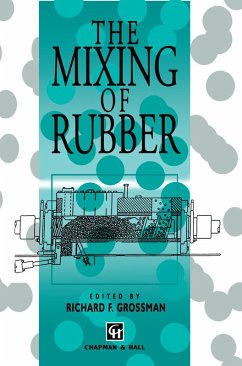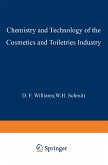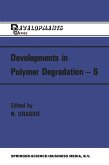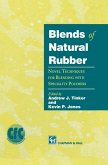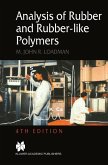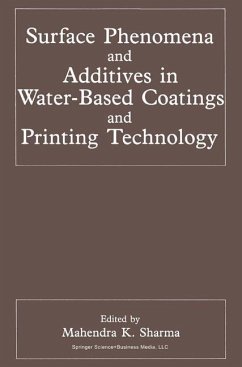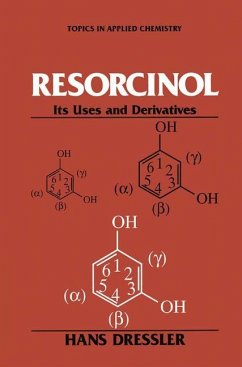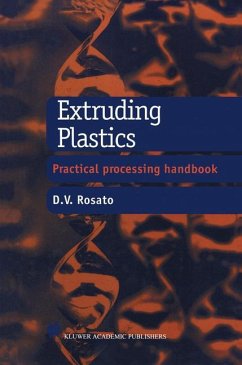The Mixing of Rubber
Herausgegeben:Grossman, R.F.
The Mixing of Rubber
Herausgegeben:Grossman, R.F.
- Broschiertes Buch
- Merkliste
- Auf die Merkliste
- Bewerten Bewerten
- Teilen
- Produkt teilen
- Produkterinnerung
- Produkterinnerung
Despite mature applications, advanced technology, and high volume, rubber compounding has never had a book of its own. Today, emerging applications such as tire reclamation and smoke-resistant cables combine with an industry push into engineering materials to create new kinds of compounds with new quality control problems. The Mixing of Rubber has been developed over several years in conjunction with the Farrel Corp./Connecticut Rubber Group course to educate the hands-on compounder and the end user as well. It covers machinery, mixing, process control, quality control, plant operations and…mehr
Andere Kunden interessierten sich auch für
![Chemistry and Technology of the Cosmetics and Toiletries Industry Chemistry and Technology of the Cosmetics and Toiletries Industry]() S.D. WilliamsChemistry and Technology of the Cosmetics and Toiletries Industry229,99 €
S.D. WilliamsChemistry and Technology of the Cosmetics and Toiletries Industry229,99 €![Developments in Polymer Degradation¿6 Developments in Polymer Degradation¿6]() Developments in Polymer Degradation¿639,99 €
Developments in Polymer Degradation¿639,99 €![Blends of Natural Rubber Blends of Natural Rubber]() K. C. JonesBlends of Natural Rubber112,99 €
K. C. JonesBlends of Natural Rubber112,99 €![Analysis of Rubber and Rubber-like Polymers Analysis of Rubber and Rubber-like Polymers]() M. J. LoadmanAnalysis of Rubber and Rubber-like Polymers112,99 €
M. J. LoadmanAnalysis of Rubber and Rubber-like Polymers112,99 €![Surface Phenomena and Additives in Water-Based Coatings and Printing Technology Surface Phenomena and Additives in Water-Based Coatings and Printing Technology]() Surface Phenomena and Additives in Water-Based Coatings and Printing Technology115,99 €
Surface Phenomena and Additives in Water-Based Coatings and Printing Technology115,99 €![Resorcinol Resorcinol]() Hans DresslerResorcinol149,99 €
Hans DresslerResorcinol149,99 €![Extruding Plastics Extruding Plastics]() D. V. RosatoExtruding Plastics150,99 €
D. V. RosatoExtruding Plastics150,99 €-
-
-
Despite mature applications, advanced technology, and high volume, rubber compounding has never had a book of its own. Today, emerging applications such as tire reclamation and smoke-resistant cables combine with an industry push into engineering materials to create new kinds of compounds with new quality control problems. The Mixing of Rubber has been developed over several years in conjunction with the Farrel Corp./Connecticut Rubber Group course to educate the hands-on compounder and the end user as well. It covers machinery, mixing, process control, quality control, plant operations and mixing advice for specific compounds. Like the course, the book assumes no prior knowledge of rubber compounding but leads the technologist through the process from mix procedure to test.
Produktdetails
- Produktdetails
- Verlag: Springer / Springer Netherlands
- Artikelnr. des Verlages: 978-94-010-6460-6
- Softcover reprint of the original 1st ed. 1997
- Seitenzahl: 264
- Erscheinungstermin: 27. September 2012
- Englisch
- Abmessung: 235mm x 155mm x 15mm
- Gewicht: 406g
- ISBN-13: 9789401064606
- ISBN-10: 9401064601
- Artikelnr.: 39503469
- Herstellerkennzeichnung Die Herstellerinformationen sind derzeit nicht verfügbar.
- Verlag: Springer / Springer Netherlands
- Artikelnr. des Verlages: 978-94-010-6460-6
- Softcover reprint of the original 1st ed. 1997
- Seitenzahl: 264
- Erscheinungstermin: 27. September 2012
- Englisch
- Abmessung: 235mm x 155mm x 15mm
- Gewicht: 406g
- ISBN-13: 9789401064606
- ISBN-10: 9401064601
- Artikelnr.: 39503469
- Herstellerkennzeichnung Die Herstellerinformationen sind derzeit nicht verfügbar.
1 Mixing machinery for rubber.- 1.1 Introduction.- 1.2 Two-roll mills.- 1.3 Internal batch mixers.- 1.4 Continuous mixers.- 1.5 Development of the Banbury mixer.- 1.6 Operating variables.- 2 Mixing cycles and procedures.- 2.1 Cost of internal mixing.- 2.2 Unit operations in mixing.- 2.3 Single-pass versus multiple-pass mixing.- 2.4 Types of mix cycle.- 2.5 Analysis of changes to the mix procedure.- References.- 3 Mill mixing.- 3.1 Introduction.- 3.2 Acceleration of first-pass compound.- 3.3 Mill mixing of specialty compounds.- 3.4 Acceleration in line with internal mixing.- 4 Quality control and the mixing process.- 4.1 Introduction.- 4.2 Testing of raw materials.- 4.3 Control of composition.- 4.4 Tracking the mix cycle.- 4.5 Compound testing.- 5 Statistical process control for industrial mixing.- 5.1 Introduction.- 5.2 Basic SPC charting.- 5.3 Rheometer data and its meaning.- 5.4 A case history.- 5.5 Summary.- 5.6 Mixing control software.- References.- 6 Additives that affect mixing.- 6.1 Introduction.- 6.2 Peptizers in natural rubber.- 6.3 Peptizers in SBR.- 6.4 Peptizers in sulfur-containing polymers.- 6.5 Additives to increase viscosity.- 6.6 Preventing unwanted chemical reactions.- References.- 7 Operation and maintenance of mixing equipment.- 7.1 Inspection of Banbury mixers.- 7.2 Mixer maintenance and lubrication.- 7.3 Anticipating required service.- 7.4 Dust stop maintenance.- 7.5 SSA dust stops.- 7.6 Banbury mixer: hydraulic dust stops.- 8 Mixing procedures for specific compounds.- 8.1 Introduction.- 8.2 EPDM expansion joint cover.- 8.3 Expansion joint intermediate layer.- 8.4 Traffic counter treadle cover.- 8.5 SBR/IR belt cover.- 8.6 EPDM low voltage electrical connector.- 8.7 Peroxide-cured black-filled EPDM compounds.- 8.8 EPDM concrete pipe gasket.- 8.9 SBR insulation.- 8.10 Injection-molded NBR gasket.- 8.11 CR/SBR blend.- 8.12 Low durometer CR/SBR blend.- 8.13 CR specification compounds.- 8.14 Charge-dissipating CR tubing.- 8.15 Nonblack CR for injection molding.- 8.16 Hard rubber industrial wheel.- 8.17 High durometer NBR masterbatch.- 8.18 NBR/PVC cable jacket.- 8.19 NBR/PVC/SBR blend.- 8.20 Butyl masterbatch.- 8.21 Butyl masterbatch, heat interacted.- 8.22 Chlorobutyl/NR blend.- 8.23 CSM cord jacket.- 8.24 Nonblack millable urethane.- 8.25 ECO molding compounds.- 8.26 Polyacrylate shaft seal.- 8.27 XLPE insulation.- 8.28 FKM molding compound.- 8.29 Silicone spark plug boot cover.- 9 Mixing wire and cable compounds.- 9.1 Introduction.- 9.2 Tempered water.- 9.3 Power-controlled mixing.- 9.4 Energy conservation.- References.- 10 Mixing ethylene-propylene diene rubber.- 10.1 Introduction.- 10.2 Background of EPDM development.- 10.3 Composition of EPDM elastomers.- 10.4 Variables in EPM and EPDM elastomers.- 10.5 How processing relates to structure and rheology.- 10.6 Practical guidelines for mixing EP elastomers.- 10.7 Summary.- References.- 11 Mixing of tire compounds.- 11.1 Introduction.- 11.2 Rework.- 11.3 Phase mixing.- 11.4 Natural rubber: viscosity reduction.- 11.5 Measurement of mixing efficiency.- References.- 12 Mixing fluoroelastomer (FKM) compounds.- 12.1 Introduction.- 12.2 Special considerations.- 12.3 Raw materials.- 12.4 Typical formulations.- 12.5 Internal mixing.- 12.6 Mill mixing.- 12.7 Summary.- 12.8 Accounting methods.- 13 Continuous mixing.- 13.1 The Farrel continuous mixer.- 13.2 Operating principles of the FCM.- 13.3 Commercial applications for the FCM.- 13.4 The Farrel mixing venting extruder (MVX).- 14 Evaluating the performance of internal mixers.- 14.1 Introduction and literature review.- 14.2Designing the rotor.- 14.3 Analysis of dispersive mixing.- 14.4 Results from synchronous rotors.- References.- Appendix Unit conversion tables and factors.- A.1 Conversion between Fahrenheit and Celsius.- A.2 Conversion of English units to metric units.
1 Mixing machinery for rubber.- 1.1 Introduction.- 1.2 Two-roll mills.- 1.3 Internal batch mixers.- 1.4 Continuous mixers.- 1.5 Development of the Banbury mixer.- 1.6 Operating variables.- 2 Mixing cycles and procedures.- 2.1 Cost of internal mixing.- 2.2 Unit operations in mixing.- 2.3 Single-pass versus multiple-pass mixing.- 2.4 Types of mix cycle.- 2.5 Analysis of changes to the mix procedure.- References.- 3 Mill mixing.- 3.1 Introduction.- 3.2 Acceleration of first-pass compound.- 3.3 Mill mixing of specialty compounds.- 3.4 Acceleration in line with internal mixing.- 4 Quality control and the mixing process.- 4.1 Introduction.- 4.2 Testing of raw materials.- 4.3 Control of composition.- 4.4 Tracking the mix cycle.- 4.5 Compound testing.- 5 Statistical process control for industrial mixing.- 5.1 Introduction.- 5.2 Basic SPC charting.- 5.3 Rheometer data and its meaning.- 5.4 A case history.- 5.5 Summary.- 5.6 Mixing control software.- References.- 6 Additives that affect mixing.- 6.1 Introduction.- 6.2 Peptizers in natural rubber.- 6.3 Peptizers in SBR.- 6.4 Peptizers in sulfur-containing polymers.- 6.5 Additives to increase viscosity.- 6.6 Preventing unwanted chemical reactions.- References.- 7 Operation and maintenance of mixing equipment.- 7.1 Inspection of Banbury mixers.- 7.2 Mixer maintenance and lubrication.- 7.3 Anticipating required service.- 7.4 Dust stop maintenance.- 7.5 SSA dust stops.- 7.6 Banbury mixer: hydraulic dust stops.- 8 Mixing procedures for specific compounds.- 8.1 Introduction.- 8.2 EPDM expansion joint cover.- 8.3 Expansion joint intermediate layer.- 8.4 Traffic counter treadle cover.- 8.5 SBR/IR belt cover.- 8.6 EPDM low voltage electrical connector.- 8.7 Peroxide-cured black-filled EPDM compounds.- 8.8 EPDM concrete pipe gasket.- 8.9 SBR insulation.- 8.10 Injection-molded NBR gasket.- 8.11 CR/SBR blend.- 8.12 Low durometer CR/SBR blend.- 8.13 CR specification compounds.- 8.14 Charge-dissipating CR tubing.- 8.15 Nonblack CR for injection molding.- 8.16 Hard rubber industrial wheel.- 8.17 High durometer NBR masterbatch.- 8.18 NBR/PVC cable jacket.- 8.19 NBR/PVC/SBR blend.- 8.20 Butyl masterbatch.- 8.21 Butyl masterbatch, heat interacted.- 8.22 Chlorobutyl/NR blend.- 8.23 CSM cord jacket.- 8.24 Nonblack millable urethane.- 8.25 ECO molding compounds.- 8.26 Polyacrylate shaft seal.- 8.27 XLPE insulation.- 8.28 FKM molding compound.- 8.29 Silicone spark plug boot cover.- 9 Mixing wire and cable compounds.- 9.1 Introduction.- 9.2 Tempered water.- 9.3 Power-controlled mixing.- 9.4 Energy conservation.- References.- 10 Mixing ethylene-propylene diene rubber.- 10.1 Introduction.- 10.2 Background of EPDM development.- 10.3 Composition of EPDM elastomers.- 10.4 Variables in EPM and EPDM elastomers.- 10.5 How processing relates to structure and rheology.- 10.6 Practical guidelines for mixing EP elastomers.- 10.7 Summary.- References.- 11 Mixing of tire compounds.- 11.1 Introduction.- 11.2 Rework.- 11.3 Phase mixing.- 11.4 Natural rubber: viscosity reduction.- 11.5 Measurement of mixing efficiency.- References.- 12 Mixing fluoroelastomer (FKM) compounds.- 12.1 Introduction.- 12.2 Special considerations.- 12.3 Raw materials.- 12.4 Typical formulations.- 12.5 Internal mixing.- 12.6 Mill mixing.- 12.7 Summary.- 12.8 Accounting methods.- 13 Continuous mixing.- 13.1 The Farrel continuous mixer.- 13.2 Operating principles of the FCM.- 13.3 Commercial applications for the FCM.- 13.4 The Farrel mixing venting extruder (MVX).- 14 Evaluating the performance of internal mixers.- 14.1 Introduction and literature review.- 14.2Designing the rotor.- 14.3 Analysis of dispersive mixing.- 14.4 Results from synchronous rotors.- References.- Appendix Unit conversion tables and factors.- A.1 Conversion between Fahrenheit and Celsius.- A.2 Conversion of English units to metric units.

